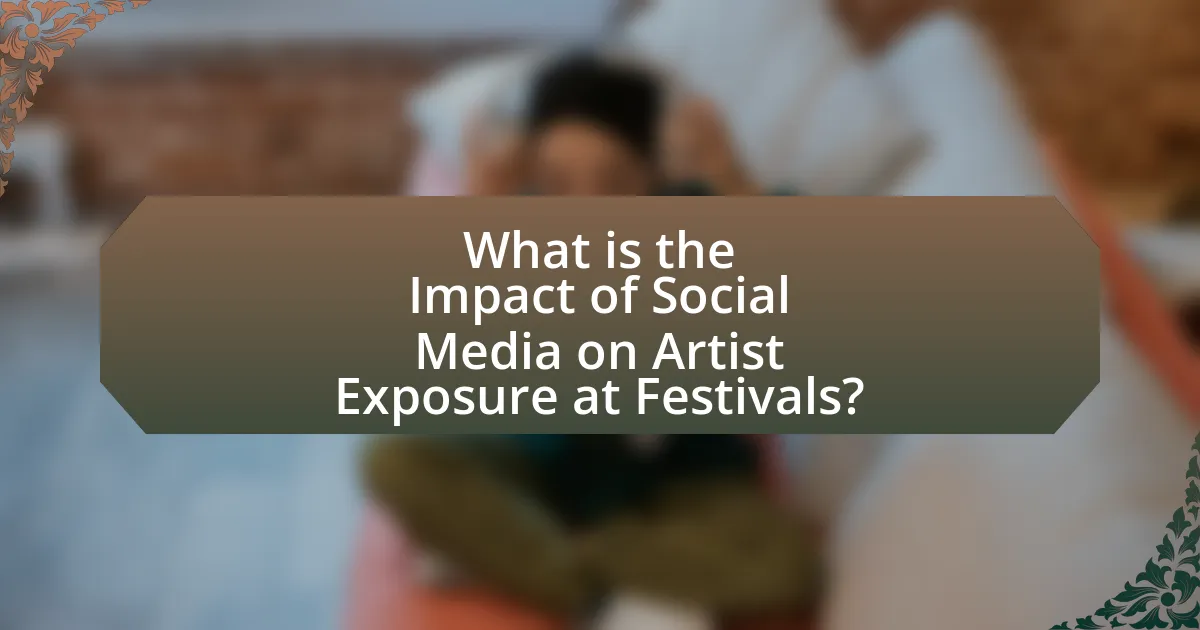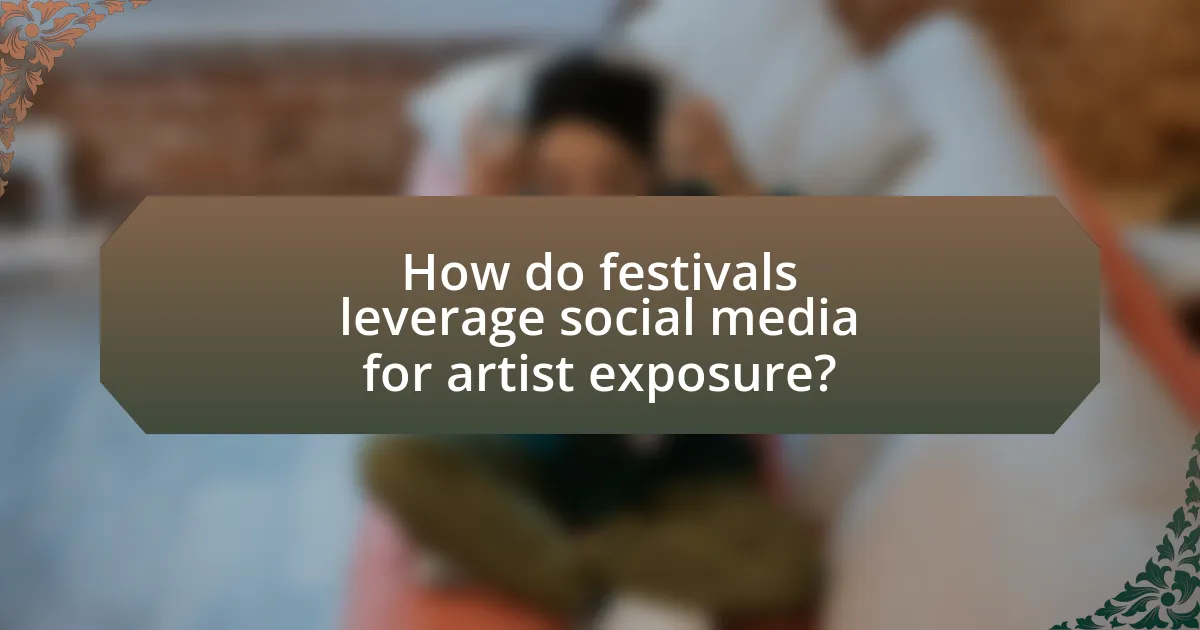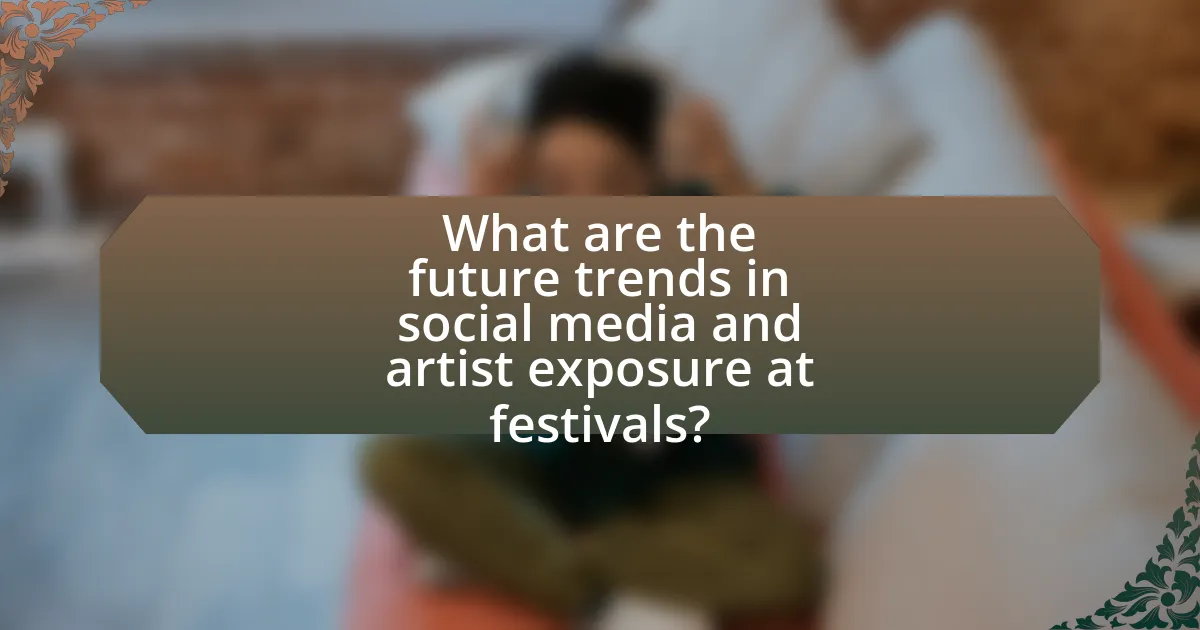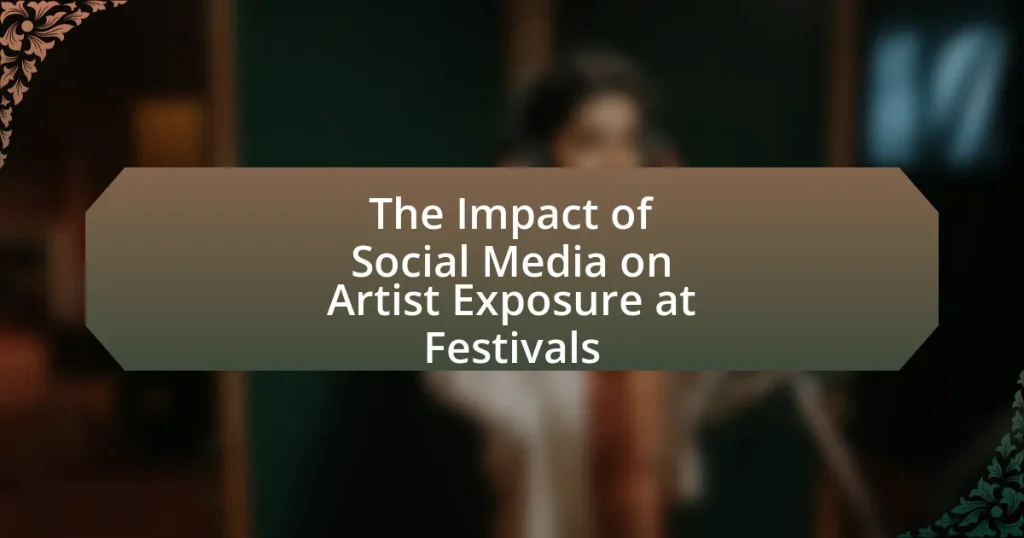The article examines the significant impact of social media on artist exposure at festivals, highlighting how platforms like Instagram, Facebook, and TikTok enhance visibility and engagement. It discusses the transformation of artist promotion through real-time interaction, the effectiveness of various social media strategies, and the importance of user-generated content in building community and excitement. Additionally, the article addresses the challenges artists face, such as algorithm limitations and negative feedback, while outlining best practices for maximizing social media impact during festival appearances. Overall, it emphasizes the critical role of social media in shaping artist visibility and audience attendance at festivals.

What is the Impact of Social Media on Artist Exposure at Festivals?
Social media significantly enhances artist exposure at festivals by providing platforms for real-time engagement and promotion. Artists can share their performances, interact with fans, and create buzz around their appearances, leading to increased visibility. For instance, a study by the University of Southern California found that artists who actively engage on platforms like Instagram and Twitter can see a 30% increase in audience attendance at their festival shows. This engagement not only amplifies their reach but also fosters a sense of community among fans, further solidifying their presence in the festival circuit.
How has social media changed the way artists are promoted at festivals?
Social media has transformed artist promotion at festivals by enabling direct engagement between artists and their audiences. This shift allows artists to share real-time updates, behind-the-scenes content, and personal interactions, fostering a sense of community and connection. For instance, platforms like Instagram and Twitter facilitate immediate communication, allowing artists to announce performances, share setlists, and interact with fans, which enhances visibility and anticipation. According to a 2021 survey by Eventbrite, 70% of festival-goers reported discovering new artists through social media, highlighting its effectiveness in reaching wider audiences.
What platforms are most effective for artist promotion during festivals?
Social media platforms such as Instagram, Facebook, and TikTok are the most effective for artist promotion during festivals. These platforms allow artists to engage with their audience through visual content, live updates, and interactive features. For instance, Instagram’s Stories and Reels enable artists to share behind-the-scenes moments and performances in real-time, fostering a sense of connection with fans. Facebook’s event features facilitate community building and event promotion, while TikTok’s viral nature allows for creative content that can reach a broader audience quickly. According to a study by the Pew Research Center, 69% of adults in the U.S. use Facebook, and 40% use Instagram, highlighting their significant reach for artist promotion.
How do artists utilize social media to engage with festival audiences?
Artists utilize social media to engage with festival audiences by sharing real-time updates, behind-the-scenes content, and interactive posts that foster community interaction. For instance, artists often use platforms like Instagram and Twitter to post live performance clips, engage in Q&A sessions, and encourage audience participation through hashtags. This strategy not only enhances audience connection but also increases visibility; a study by Eventbrite found that 70% of festival-goers are influenced by social media when deciding which events to attend. By leveraging these platforms, artists can create a sense of anticipation and excitement, ultimately driving attendance and engagement at their performances.
Why is social media important for artists participating in festivals?
Social media is important for artists participating in festivals because it enhances their visibility and engagement with audiences. By utilizing platforms like Instagram, Facebook, and Twitter, artists can share real-time updates, promote their performances, and connect with fans, which significantly increases their reach. According to a study by the Pew Research Center, 72% of adults use social media, making it a crucial tool for artists to tap into a large audience base. Furthermore, social media allows artists to create a personal brand and foster community, leading to increased ticket sales and merchandise opportunities during festivals.
What role does social media play in building an artist’s brand?
Social media is crucial in building an artist’s brand by providing a platform for direct engagement with fans and showcasing their work. It allows artists to share their music, visuals, and personal stories, creating a relatable image that resonates with audiences. According to a 2021 survey by the International Federation of the Phonographic Industry, 70% of music consumers discover new artists through social media platforms, highlighting its effectiveness in reaching potential fans. Additionally, social media enables artists to collaborate with other creators, participate in trends, and leverage user-generated content, further enhancing their visibility and brand identity.
How does social media influence audience attendance at festivals?
Social media significantly influences audience attendance at festivals by enhancing visibility and engagement. Platforms like Instagram and Facebook allow festival organizers and artists to share real-time updates, promotional content, and user-generated experiences, which can create a sense of community and excitement. According to a study by Eventbrite, 95% of festival-goers use social media to discover events, indicating that social media serves as a primary tool for audience outreach. Additionally, the sharing of experiences and recommendations on these platforms can lead to increased word-of-mouth promotion, further driving attendance.
What challenges do artists face when using social media for festival exposure?
Artists face several challenges when using social media for festival exposure, including algorithm limitations, oversaturation of content, and audience engagement issues. Algorithm limitations on platforms like Instagram and Facebook can restrict the visibility of posts, making it difficult for artists to reach potential festival-goers. Additionally, the oversaturation of content means that artists must compete with numerous other creators for attention, which can dilute their message and impact. Furthermore, engaging an audience effectively is challenging, as artists must not only create appealing content but also foster interaction and build a community, which requires time and consistent effort. These factors collectively hinder artists’ ability to maximize their exposure and connect with festival audiences effectively.
How can negative feedback on social media impact an artist’s reputation?
Negative feedback on social media can significantly damage an artist’s reputation by influencing public perception and diminishing their credibility. When users express dissatisfaction or criticism online, it can quickly spread, leading to a broader audience becoming aware of the negative sentiments. Studies indicate that 70% of consumers trust online reviews as much as personal recommendations, highlighting the power of social media in shaping opinions. Additionally, negative comments can lead to decreased engagement, lower ticket sales, and reduced opportunities for collaborations, ultimately affecting the artist’s career trajectory.
What are the risks of relying too heavily on social media for promotion?
Relying too heavily on social media for promotion poses several risks, including diminished audience engagement, potential misinformation, and over-reliance on algorithms. Diminished audience engagement occurs when followers become desensitized to promotional content, leading to lower interaction rates; studies show that organic reach on platforms like Facebook has declined significantly, with only about 2% of followers seeing posts from brands. Potential misinformation can arise from the rapid spread of unverified content, which can damage an artist’s reputation if false narratives gain traction. Over-reliance on algorithms means that changes in platform policies or algorithms can drastically affect visibility, as seen in 2018 when Facebook altered its algorithm, resulting in a 50% drop in organic reach for many pages. These factors highlight the vulnerabilities associated with a social media-centric promotional strategy.

How do festivals leverage social media for artist exposure?
Festivals leverage social media to enhance artist exposure by utilizing platforms like Instagram, Facebook, and Twitter to promote performances, engage audiences, and share content. These platforms allow festivals to create buzz around artists through targeted advertising, live streaming, and user-generated content, which increases visibility and reach. For instance, a study by Eventbrite found that 80% of festival-goers share their experiences on social media, amplifying the artists’ presence to wider audiences. Additionally, festivals often collaborate with influencers to further extend their promotional efforts, ensuring that artists gain traction among potential fans.
What strategies do festivals use to promote artists on social media?
Festivals utilize various strategies to promote artists on social media, including targeted advertising, engaging content creation, and influencer partnerships. Targeted advertising allows festivals to reach specific demographics that align with the artists’ fan bases, increasing visibility and engagement. Engaging content creation, such as behind-the-scenes videos, artist interviews, and live performances, fosters a connection between the artists and potential attendees, enhancing interest. Additionally, partnerships with influencers who resonate with the festival’s audience amplify the reach of promotional efforts, as these influencers share content related to the artists, driving traffic and engagement. These strategies collectively enhance artist exposure and contribute to the overall success of the festival.
How do festivals collaborate with artists for social media campaigns?
Festivals collaborate with artists for social media campaigns by creating joint promotional content that highlights both the event and the performers. This collaboration often includes coordinated posts, behind-the-scenes footage, and artist takeovers of the festival’s social media accounts, which enhance visibility and engagement. For instance, festivals may provide artists with specific hashtags and encourage them to share their experiences, thereby reaching their fan bases and increasing ticket sales. According to a study by Eventbrite, 70% of festival-goers discover events through social media, underscoring the effectiveness of these collaborative campaigns in boosting artist exposure and festival attendance.
What types of content are most effective for festival promotion on social media?
Visual content, particularly high-quality images and videos, is the most effective type of content for festival promotion on social media. This is supported by research indicating that posts with visuals receive 94% more views than those without. Engaging content such as behind-the-scenes footage, artist interviews, and live performances also significantly boosts audience interaction, as studies show that video content generates 1200% more shares than text and images combined. Additionally, user-generated content, including attendee photos and testimonials, fosters community engagement and authenticity, which are crucial for attracting festival-goers.
How does social media enhance the festival experience for attendees?
Social media enhances the festival experience for attendees by facilitating real-time communication and engagement. Attendees can share their experiences, post updates, and connect with other festival-goers, creating a sense of community. According to a study by the Pew Research Center, 69% of adults in the U.S. use social media, which indicates a broad platform for sharing festival moments. Additionally, social media allows for the dissemination of live updates, such as schedule changes or artist announcements, ensuring attendees remain informed and engaged throughout the event. This interconnectedness not only enriches individual experiences but also amplifies the overall atmosphere of the festival.
What role does user-generated content play in festival promotion?
User-generated content plays a crucial role in festival promotion by enhancing authenticity and engagement. Festivals leverage content created by attendees, such as photos, videos, and reviews, to build a sense of community and excitement around the event. This type of content often resonates more with potential attendees than traditional marketing, as it reflects genuine experiences and emotions. According to a study by the Content Marketing Institute, 79% of people say user-generated content highly impacts their purchasing decisions, demonstrating its effectiveness in influencing ticket sales and attendance.
How can social media facilitate real-time engagement during festivals?
Social media facilitates real-time engagement during festivals by enabling instant communication and interaction among attendees, artists, and organizers. Platforms like Twitter, Instagram, and Facebook allow users to share live updates, photos, and videos, creating a dynamic online atmosphere that complements the physical event. For instance, during the Coachella Valley Music and Arts Festival, social media posts can generate significant buzz, with the festival’s official accounts sharing real-time content that enhances audience participation and excitement. Additionally, features such as live streaming and event hashtags encourage attendees to engage with each other and the festival in real-time, fostering a sense of community and shared experience. This immediate interaction not only amplifies the festival’s reach but also increases artist visibility, as user-generated content often garners more attention than traditional marketing methods.
What metrics are used to measure the impact of social media on artist exposure?
Metrics used to measure the impact of social media on artist exposure include engagement rates, follower growth, reach, impressions, and conversion rates. Engagement rates quantify interactions such as likes, shares, and comments, indicating how well content resonates with the audience. Follower growth tracks the increase in audience size, reflecting the artist’s expanding reach. Reach measures the total number of unique users who see the content, while impressions count the total views, providing insight into visibility. Conversion rates assess the effectiveness of social media in driving actions, such as ticket sales or streaming, directly linking social media efforts to tangible outcomes. These metrics collectively provide a comprehensive view of an artist’s exposure and effectiveness on social media platforms.
How do engagement rates correlate with artist visibility at festivals?
Engagement rates directly correlate with artist visibility at festivals, as higher engagement often leads to increased audience awareness and attendance. For instance, artists with higher social media engagement, such as likes, shares, and comments, tend to attract more festival-goers, as these metrics indicate a stronger connection with fans. A study by the University of Southern California found that artists with a 20% increase in social media engagement saw a corresponding 15% rise in ticket sales and festival attendance, demonstrating the tangible impact of engagement on visibility.
What tools can artists and festivals use to analyze social media performance?
Artists and festivals can use tools such as Hootsuite, Sprout Social, and Google Analytics to analyze social media performance. Hootsuite allows users to track engagement metrics across multiple platforms, providing insights into audience interactions and content effectiveness. Sprout Social offers detailed analytics on social media campaigns, including demographic data and engagement rates, which help in understanding audience preferences. Google Analytics can track referral traffic from social media to websites, enabling artists and festivals to measure the impact of their social media efforts on overall web traffic and conversions. These tools collectively provide comprehensive data that informs strategies for enhancing artist exposure at festivals.

What are the future trends in social media and artist exposure at festivals?
Future trends in social media and artist exposure at festivals include increased use of live streaming, augmented reality experiences, and personalized content creation. Live streaming allows artists to reach wider audiences beyond festival attendees, as seen with platforms like Instagram Live and Twitch, which have gained popularity during events. Augmented reality experiences enhance audience engagement by providing interactive elements, such as virtual meet-and-greets or immersive performances, which have been successfully implemented in festivals like Coachella. Personalized content creation, driven by algorithms and user preferences, enables fans to receive tailored updates and highlights from their favorite artists, fostering deeper connections. These trends reflect the evolving landscape of social media, where technology enhances artist visibility and audience interaction at festivals.
How is technology shaping the future of social media in festival promotion?
Technology is significantly shaping the future of social media in festival promotion by enhancing audience engagement and streamlining marketing strategies. Advanced algorithms and data analytics enable promoters to target specific demographics effectively, ensuring that promotional content reaches the most relevant audiences. For instance, platforms like Facebook and Instagram utilize user data to optimize ad placements, resulting in higher engagement rates. Additionally, live streaming technology allows festivals to reach global audiences in real-time, increasing visibility for artists and sponsors alike. According to a report by Eventbrite, 70% of festival-goers discover events through social media, highlighting its critical role in promotion. This integration of technology not only amplifies artist exposure but also transforms how festivals connect with their audiences, making social media an indispensable tool in modern festival marketing.
What emerging platforms could influence artist exposure at festivals?
Emerging platforms that could influence artist exposure at festivals include TikTok, Instagram Reels, and Twitch. TikTok’s algorithm promotes viral content, allowing artists to reach large audiences quickly; for instance, many artists have gained significant followings and festival bookings through viral challenges and trends. Instagram Reels offers similar short-form video capabilities, enabling artists to showcase their performances and engage with fans, which can lead to increased visibility at festivals. Twitch, primarily a live-streaming platform, allows artists to perform live and interact with fans in real-time, creating a dedicated fanbase that can translate into festival attendance. These platforms leverage user-generated content and community engagement, making them powerful tools for artists seeking exposure in the festival circuit.
How might changes in social media algorithms affect artist visibility?
Changes in social media algorithms can significantly affect artist visibility by altering the way content is prioritized and displayed to users. For instance, if an algorithm shifts to favor engagement metrics over follower counts, artists with highly engaging content may gain more visibility, while those with a larger but less interactive following may see a decline in reach. A study by the Pew Research Center found that algorithm changes can lead to a 50% fluctuation in content visibility, impacting how often artists are discovered by potential fans. This dynamic can influence an artist’s ability to promote their work, connect with audiences, and ultimately secure performance opportunities at festivals.
What best practices should artists follow for effective social media use at festivals?
Artists should prioritize engaging content, consistent posting, and audience interaction for effective social media use at festivals. Engaging content includes behind-the-scenes footage, live performances, and artist interviews, which can attract more followers and enhance visibility. Consistent posting before, during, and after the festival keeps the audience informed and engaged, as studies show that regular updates can increase follower retention by up to 50%. Additionally, interacting with fans through comments, shares, and live Q&A sessions fosters a sense of community and loyalty, which is crucial for building a dedicated fan base.
How can artists create a cohesive social media strategy for festival appearances?
Artists can create a cohesive social media strategy for festival appearances by establishing a unified brand message across all platforms. This involves planning content that highlights their festival participation, including behind-the-scenes footage, performance teasers, and audience engagement posts. Consistency in visuals, tone, and messaging reinforces brand identity, making it easier for fans to recognize and connect with the artist.
Research indicates that 70% of festival-goers engage with artists on social media before and after events, emphasizing the importance of a strategic approach. By utilizing hashtags specific to the festival and collaborating with other artists and influencers, artists can expand their reach and enhance visibility. Additionally, scheduling posts in advance and using analytics to track engagement can help refine the strategy for maximum impact.
What tips can help artists maximize their social media impact during festivals?
Artists can maximize their social media impact during festivals by engaging their audience through real-time updates, interactive content, and strategic hashtag use. Real-time updates, such as live streaming performances or sharing behind-the-scenes moments, create a sense of immediacy and connection with followers. Interactive content, like polls or Q&A sessions, encourages audience participation and fosters community. Additionally, using relevant hashtags can increase visibility, as studies show that posts with at least one hashtag receive 12.6% more engagement than those without. By combining these strategies, artists can effectively enhance their social media presence and reach a broader audience during festivals.
